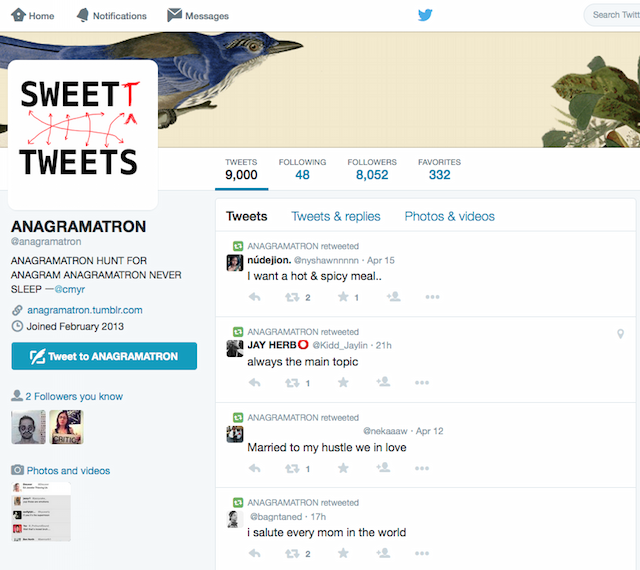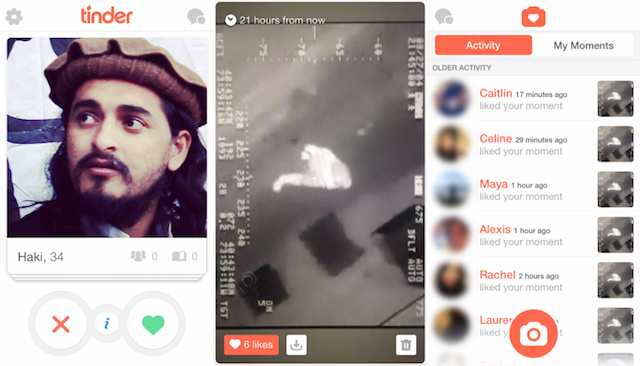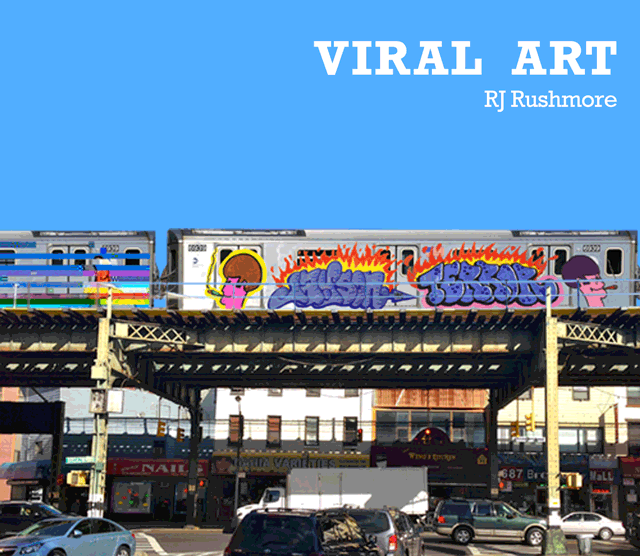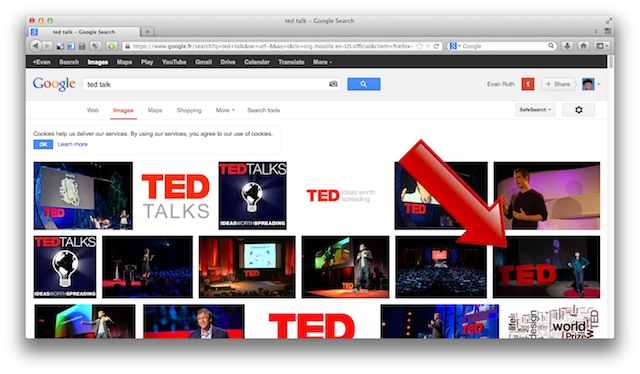
It’s no secret that Twitter bots can be pretty entertaining and/or confusing. Sometimes they’re artworks or jokes. Sometimes they’re somewhat useful tools or coding experiments. Generally speaking though (and excluding spambots), Twitter bots don’t actually interact with other users. You could follow @everyword, but it wasn’t going to follow you back or respond to your tweets. And most of the bots that will respond to your tweets won’t respond unless you’ve reached out to them in some way first (like @DearAssistant). There are, however, a handful of non-spambot Twitter bots that will find you even if you’re not looking for them. These bots are examples of invasive viral art, art that exists only online but acts a bit like street art or graffiti, treating the Twitter stream as public space and public tweets as content to appropriate or engage with.
So what do these invasive viral art Twitter bots look like and do? They all seek out other users’ tweets to engage with, and from there things can go in a few different directions.
Darius Kazemi, one of the most prolific and best-known creators of Twitter bots, has @VeryOldTweets. The bot simply “retweets one of the first 7500 tweets (first 90 days of Twitter) four times a day.” The tweets of Twitter’s earliest users are recontextualized as a semi-random look back at “history.” As much as the bot is interesting to random outside observers, there’s also the engagement of the users whose content is being appropriated. I would find it weird and a bit shocking if a tweet of mine from almost a decade ago was suddenly retweeted.
The most obviously “artistic” Twitter bots of this sort relate to poetry and word games.
Colin Rofls has @ANAGRAMATRON and @HAIKU9000. Both bots mine Twitter and then combine “matching” tweets from separate, otherwise unrelated, users.
@ANAGRAMATRON finds tweets that are anagrams and then retweet the matching pairs. For example, on April 9th, @pranksterstyles tweeted “i did my nails before”, and on April 19th, @warneholly tweeted “I’m so drained by life”. When @ANAGRAMATRON found that the pair matched, it notifies Rofls, and with his okay, the bot retweeted both tweets. @ANAGRAMATRON’s retweets are approved by Rofls so the process isn’t completely automated, but that’s mostly to keep out spambots. It’s still the algorithm doing most of the work. As Rofls notes, “[anagrams are] especially interesting because they’re so hard to come up with manually.” Really, without any cheating, who was ever going to think up the pair “i did my nails before” and “I’m so drained by life”?
Similarly, @HAIKU9000 searches for tweets that each fit the rules to be one line in a haiku, and then combines three such tweets into one poem/tweet with credit to its sources, pulling together disconnected Twitter users and appropriating their words in a way that was probably not the author’s intent.
Hug a mom today! I’ve been drunk the past three days. She throwing me off — (@)RainCityRCA / (@)___kaaatherine / (@)ItsJussFrankie
— HAIKU9000 (@HAIKU9000) May 10, 2015
Maybe I’m just too naively optimistic, but I wonder if any of the users appropriated by @ANAGRAMATRON or @HAIKU9000 have ever connected with one another after their tweets were brought together by the bots. I asked Rofls how people respond to his bots, but the result was disheartening. He said, “Mostly they don’t, to be honest. Very occasionally they’re thrilled, sometimes confused, but mostly just silent.”
Rofls was inspired to create @ANAGRAMATRON after seeing Ranjit Bhatnagar‘s @pentametron, a very popular Twitter bot with this fantastic bio: “With algorithms subtle and discrete / I seek iambic writings to retweet.” Like @ANAGRAMATRON, @pentametron searches out matching pairs to retweet, in this case tweets in iambic pentameter that get retweeted together as rhyming couplets (“You fuel my desire to succeed.” / “How many chances does Hernandez need!”)
And then there’s the (currently inactive) Accidental Haiku from Cameron Spencer, which used to find entire tweets that could be broken down into a single haiku. For example:
PIZZA IS HOLY / AND YALL NEED JESUS WHEN YOU / SEE PIZZA THAT WAY / #accidentalhaiku by @princedreamboat — Accidental Haiku (@accidental575) July 17, 2014
The other major category of bots search for certain keywords and offer an (often unexpected) canned response, usually related to pop culture. Maybe not as intricate or clever as the anagram and poetry bots, but a pleasant or confusing surprise for users nonetheless.
Colin Mitchell has been a bunch of these kinds of bots, but unfortunately most are currently inactive/retired (@mirror_magick, @for_a_dollar, @iaminigomontoya). My personal favorite from Mitchell is perhaps the most predictable, but it’s also still active: @Betelgeuse_3. Simply tweet the magic words (“Beetlejuice Beetlejuice Beetlejuice”), and see what happens… Like this guy did.
The most famous bot in this category is probably @DBZNappa. Do you know how often people tweet about something being “over 9000”? Apparently, it’s all the freaking time, because @DBZNappa responds to all of those tweets with “WHAT?! NINE THOUSAND?!”, from a Dragon Ball Z meme, and the bot has tweeted well over a million times since it when live in November 2009. Daniel Lo Nigro, who created the bot, describes it as “a pretty good example of a simple ‘search and reply’ Twitter bot, that could easily be extended to do more useful things.”
A personal favorite of mine, although now inactive, is @StealthMountain, which responds to tweets that use the phrase “sneak peak” instead of”sneak peek”. The one beautiful thing about this bot now being inactive is its last tweet:
@BillGates I think you mean “sneak peek” — Stealth Mountain (@StealthMountain) December 14, 2014
Good catch, @StealthMountain.
Of course, there’s no better bot to end on than the most hilarious and low-brow: @fart_robot. The bot searches out mentions of farts on Twitter, and retweets them to its 12,000+ followers with the note: “FART ROBOT APPROVES.” For example:
RT @KathCalabro Sometimes when I fart my fiancé literally gags.. FART ROBOT APPROVES.
— FART ROBOT (@fart_robot) April 27, 2015
While not all of these bots creators (Daniel Lo Nigro for example) consider their bots to be artworks, I disagree. Or, the very at least, I think bots like @DBZNappa can/should inspire artworks. It’s fascinating that you could just be going about your day, tweeting whatever silly thing you might tweet to your followers, only to have your words appropriated by @pentametron or to be perhaps mildly embarrassed by @fart_robot, which is not unlike walking to work and being surprised by a piece of street art or graffiti. Most people might ignore that piece or street art or an odd retweet, but for some, the occurrence catches them at just the right moment and it affects them.
We live our lives in the public spaces of the internet. Let’s put art there. I hope there are more Twitter bots to come.





